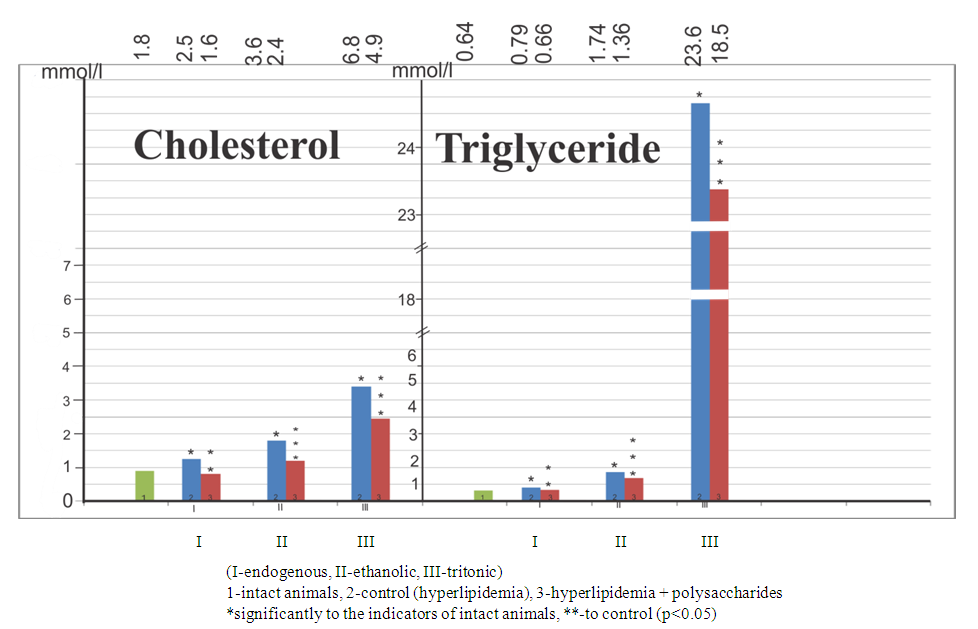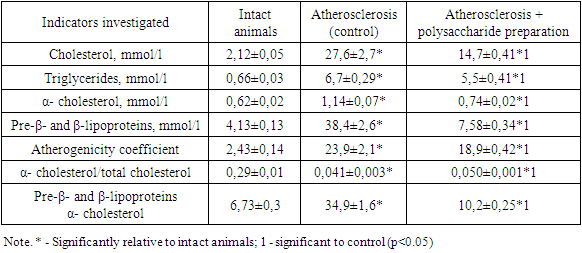-
Paper Information
- Next Paper
- Previous Paper
- Paper Submission
-
Journal Information
- About This Journal
- Editorial Board
- Current Issue
- Archive
- Author Guidelines
- Contact Us
American Journal of Medicine and Medical Sciences
p-ISSN: 2165-901X e-ISSN: 2165-9036
2024; 14(1): 144-146
doi:10.5923/j.ajmms.20241401.32
Received: Jan. 1, 2024; Accepted: Jan. 17, 2024; Published: Jan. 26, 2024

Hypolipidemic and Antiatherosclerotic Activity of Polysaccharides of Ferula Kuhistanica
Saidkhojaeva D. M., Rahmanberdyeva R. K., Syrov V. N., Shakhmurova G. A.
Institute of Chemistry of Plant Substances named after Academician S.Yu. Yunusov Academy of Sciences of the Republic of Uzbekistan, Tashkent, Uzbekistan
Correspondence to: Shakhmurova G. A., Institute of Chemistry of Plant Substances named after Academician S.Yu. Yunusov Academy of Sciences of the Republic of Uzbekistan, Tashkent, Uzbekistan.
| Email: |  |
Copyright © 2024 The Author(s). Published by Scientific & Academic Publishing.
This work is licensed under the Creative Commons Attribution International License (CC BY).
http://creativecommons.org/licenses/by/4.0/

This scientific work is devoted to the study of the hypolipidemic and antiatherosclerotic activity of Ferula Kuhistanica polysaccharides. Experiments were carried out on rats and rabbits. It was revealed that in experiments on rats with reproducible hyperlipidemic conditions, when administered prophylactically, and in experiments on atherosclerotic rabbits, when administered prophylactically, it slows down the development of negative changes in lipid metabolism.
Keywords: Polysaccharide, Ferula kuhistanica, Lipid metabolism, Antiatherosclerosis, Blood, Rats and rabbits
Cite this paper: Saidkhojaeva D. M., Rahmanberdyeva R. K., Syrov V. N., Shakhmurova G. A., Hypolipidemic and Antiatherosclerotic Activity of Polysaccharides of Ferula Kuhistanica, American Journal of Medicine and Medical Sciences, Vol. 14 No. 1, 2024, pp. 144-146. doi: 10.5923/j.ajmms.20241401.32.
1. Introduction
- Plant polysaccharides are attracting increasing attention in recent years due to the identification of their numerous biological effects indicating the promising use of these substances in therapeutic and prophylactic purposes [1]. The discovery of hypolipidemic and antiatherosclerotic effects in some polysaccharides could be one of the promising directions in this respect [2,3]. Continuing research in this aspect, we studied a total polysaccharide preparation isolated from Ferula kuhistanica plant widespread in the Central Asian region. Its effect on lipid metabolism state was studied in rats with hyperlipidemia and in rabbits directly with experimental atherosclerosis.
2. Materials and Methods
- Total preparation of polysaccharides, extracted from above-ground parts of Ferula kuhistanica [4], used in experiments contains galacturonic acid and neutral monosaccharides: galactose, glucose, arabinose, xylose and rhamnose in the ratio 8.2:2.1:1.0:4.3:1.0. Hypolipidemic and anti-atherosclerotic properties of the preparation were studied in 42 outbred white rats (males, 200-250 g) - normal and with experimental hyperlipidemia, as well as in 18 rabbits (3-3.5 kg males) of grey chinchilla breed with experimental atherosclerosis (the experiments were performed in duplicate). The drug in all cases was administered per os at a dose of 250 mg/kg (in preliminary studies established as the most effective). Experiments were performed in compliance with international regulations (Directive 2010/63/EU of the European Parliament and of the Council of the European Union of 22 September 2010 on the protection of animals used for scientific purposes). The animals were slaughtered by immediate decapitation under mild ether anaesthesia. Normal rats were administered the test drug either once or for 7 days. In case of reproducing hyperlipidemia the drug was administered for the preceding seven days. Endogenous hyperlipidemia was induced according to the method [5] - animals were deprived of food for 24 hours with unlimited access to water.Ethanol hyperlipidemia was induced by injecting rats with 50% ethanol solution for three days in increasing doses, the animals being taken into the experiment after 10 hours (before ethanol injection the rats had been fasted for 8 hours with an unrestricted access to water) [6]. Triton hyperlipidemia was induced by intraperitoneal injection of triton WR-1339 at a dose of 225 mg/kg into rats, they were used in the experiment after 17 hours [7].Atherosclerosis in rabbits was reproduced by per os injection of cholesterol solution in cotton oil at a dose of 0.3 g/kg for 3 months. One month later the animals were also orally administered the test total polysaccharide preparation and administered until the end of the experiment. Cholesterol, triglycerides, pre-β- and β-lipoprotein fractions and α-cholesterol content in animal serum were determined using Cypress diagnostics (Belgium) biochemical kits on Secomam-UV-Vis Basic VI.18 biochemical analyzer from Secomam (France). In the aorta cholesterol was determined according to the method [8], triglycerides according to the method [9]. Numerical data were statistically processed using Student's t-criterion.
3. The Results of Research
- The experiments showed that a single injection of total preparation of polysaccharides from Ferula kuhistanica into rats caused no significant changes in cholesterol and triglycerides content in serum of intact animals (reduction by 7.8 and 4.2% with p>0.05). Reliable reductions in cholesterol by 22.2% and triglycerides by 14.1% were observed after 7 days of administration. More pronounced hypolipidemic effect of the polysaccharide preparation was observed in models of reproduced hyperlipidemia. Thus, its pretreatment for 7 days largely prevented the development of mobilizing hyperlipidemia in fasting rats: the serum levels of total cholesterol and triglycerides were 36.0 and 16.5% lower in comparison with the control animals and practically corresponded to the norm (Fig. 1). In rats with ethanol hyperlipidemia pretreated with polysaccharide preparation, serum cholesterol and triglycerides contents were 33.3 and 21.2% lower than in the corresponding control animals, while in rats with triton hyperlipidemia treated with polysaccharide preparation, they were 27.9 and 21.6% lower than the control animals (Fig. 1). Data on the ability of the polysaccharide preparation from F. kuhistanica to improve lipid metabolism in case of its pathological shifts were also confirmed in experiments on rabbits with experimental atherosclerosis.
 | Figure 1. Effect of the amount of polysaccharides from Ferula kuhistanica on the content of cholesterol and triglycerides in the blood serum of rats with experimental hyperlipidemias |
|
4. Conclusions
- Thus, the total polysaccharide preparation from F. kuhistanica both in experiments on rats with reproducible hyperlipidemic conditions with prophylactic administration, and in experiments on atherosclerotic rabbits with prophylactic-treatment administration, restrained the development of negative changes in lipid metabolism. The revealed hypolipidemic and antiatherosclerotic properties of the polysaccharide preparation from F. kuhistanica, as well as the majority of other compounds of plant origin previously studied by us [10,11,12] (although expressed to a lesser extent), are nevertheless of considerable interest and open the prospect of its use in practical health care for the treatment of pathological conditions of lipid metabolism.
 Abstract
Abstract Reference
Reference Full-Text PDF
Full-Text PDF Full-text HTML
Full-text HTML